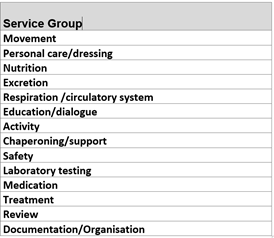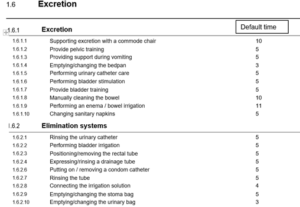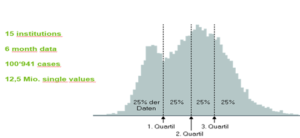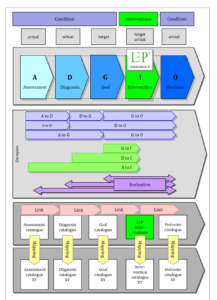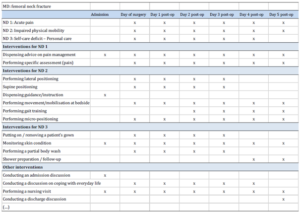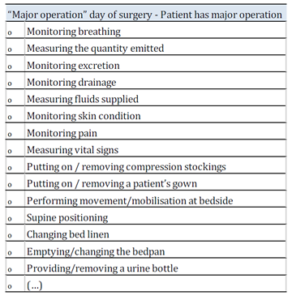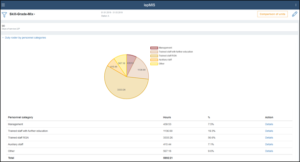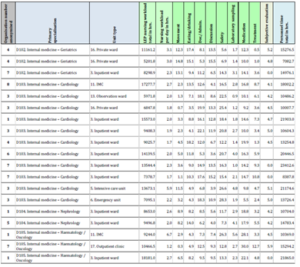Collect One, Use Many: Getting Best Use from a Standardized Nursing Classification in the EP
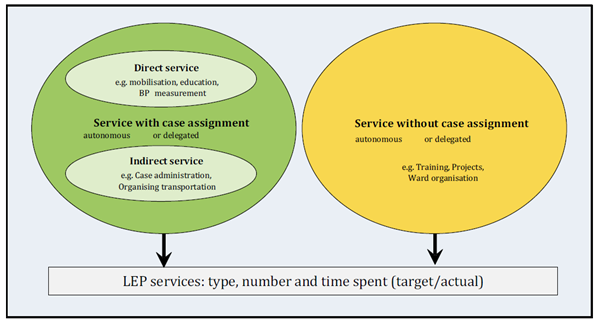
Unified Nursing Research, Midwifery & Women’s Health Journal
Volume 1, Issue 2, August 2021, Pages: 01-19
Received: July 16, 2021; Reviewed: July 16, 2021, Accepted: July 21, 2021; Published: August 19, 2021
Unified Citation Journals, Nursing 2021, https://doi.org/10.52402/Nursing201
ISSN 2754-0944
Mrs. Susanne Raeburn-Burgess, Mr. Dieter Baumberger
LEP AG, St. Gallen, Switzerland
Download PDFAbstract
The LEP® (Leistungserfassung in der Pflege; Service Recording in Healthcare) Method is a multilingual standardised nursing intervention classification and workload measurement framework; used over 800 institutions in Switzerland, Germany, Austria, and Italy. LEP records direct and indirect patient-care-related nursing activities by: case; day; and ward or unit. To quantify the time allocated to each intervention task, they are assigned a standardized (default) time. Default times are an institution-approved standard metric, based on an “average” practitioner performing an “average” task to the appropriate quality. These default times are re-evaluated regularly; in the last study around 12,5M data points were processed. LEP is a recognized standardised nursing intervention classification within the Electronic Patient Record (EPR) for documenting nursing interventions and is mapped to both ICNP and SNOMED-CT.
Automated links between nursing assessment, interventions, workload measurement, and outcomes support users in practice; whilst also increasing the nursing data’s explanatory power. LEP’s methodology is designed not only for documenting and recording data but also for analysing that information. This enables review in terms such as effectiveness or skill-grade mix.
1. Introduction
1.1 Background
The LEP® (Leistungserfassung in der Pflege; Service Recording in Healthcare, in German) methodology, as demonstrated by over 30 years of use in practice, is an efficient tool in the healthcare sector. For patient documentation, service recording, workload measurement, and the representative analysis of health care services.
For ease of reading, one should distinguish between LEP AG, the company; the LEP methodology; LEP interventions (defined according to nursing and other international healthcare standards); or LEP classifications, a standardised grouping of such interventions.
LEP methodology is currently used by around 800 organizations in Switzerland, Germany, and Austria, and expanding across Europe. It shows both direct and indirect patient-care-related nursing interventions, according to the case, day, and ward or unit.
The methodology was specifically developed as a multi-purpose classification for use in different fields in different practical applications with different volumes of data and different levels of detail for a variety of different user groups. This flexibility means that it can be optimised to reflect the intended use of case and service data, as well as organisation-specific contextual factors. It ensures efficient control over precision and abstraction, as well as long-term benefits. LEP methodology provides the basis for a systematic, data-driven, and learning-based approach to planning, providing, monitoring, and controlling the healthcare services provided to individuals and groups of people, with the goal of improving cost-efficiency, quality, and health. [1]
1.2 Advantages to Healthcare Organisation’s
The advantages to healthcare organisations that using LEP methodology can achieve include:
- Provide a common terminology for documenting healthcare interventions between different healthcare sectors/institutions/professionals.
- Minimises potential confusion, delay, and errors resulting from a miscommunication between care providers of different technical, specialism, educational, cultural, or language abilities.
- Delivers multiple analysis options to monitor and optimise the effectiveness and efficiency of healthcare services.
- Ensures the traceability and verifiability of the services provided.
- Systematically measuring the time spent on services in parallel to record keeping.
- Avoiding duplication of data entry in recording, by combining documentation of healthcare interventions with service workload measurement.
- Streamlining communication about healthcare interventions and services between the various actors involved, including healthcare professionals, management staff, researchers, cost bearers, politicians, and the public, especially people with an immediate need for healthcare interventions.
- Enables collation of data facilitating study and understanding of healthcare interventions and related situations, including patients’ health status (assessment, diagnosis, result/outcome), process flow, staff composition, pre-and post-calculations, costs, and prices.
- Supporting evidence-based decision-making about healthcare interventions and other services in the healthcare sector.
- Facilitate the transition of data between organisation-specific level of detail or aggregation, and to aggregate at the national or supranational level.
- Compliance with statutory conditions and provisions.
- A systematic approach to encoding healthcare interventions and other services for software applications and healthcare information systems.
The methodology facilitates the development and operation of user-friendly software systems for recording with LEP interventions relating to treatment and nursing care, quality monitoring, evaluation of results, revenue assurance and healthcare policy, among other disciplines.
The LEP methodology is based on the understanding that, for long-term success, in an open eHealth environment: Electronic Patient Records (EPR) and the associated clinical data will, whenever possible (and to an increasing extent) be of central importance for the documentation, collection, analysis and/or exchange of data for participants in the healthcare sector.
1.2 LEP classification in the EPR
Using EPR as their cornerstone, “bedside” health professionals can use their judgment to prepare documentation entries such that the quality and accuracy of the data are recorded for the patient’s benefit. EPR documentation is known to make day-to-day treatment safer and more efficient [2].
This documentation captures clinically relevant information on healthcare interventions. This requires structured and interconnected data in the form of clinical terminology, e.g., for assessments, diagnoses, interventions or outcomes. Using LEP classifications, such data can be generated to support treatment and nursing processes and/or core processes within the overall healthcare supply chain, and their documentation [3].
Fig 1 Essential components for the use of LEP classifications
LEP AG seeks to provide structured service data with the ability to be as specifically detailed and/or as high-level abstract as the user requires [4]. This is in order to ensure the most efficient use and best possible contextualisation, i.e. adaptation to local properties of any given organisation. Depending on an organisation’s objectives; LEP methodology can be used to record data levels ranging from partial to complete and from granular to non-granular. The clinical information recorded in this documentation is relevant to the health of people in need of healthcare interventions. This requires structured and interconnected data in the form of clinical terminology, e.g. for assessments, diagnoses, interventions or outcomes. With LEP, such data can be generated to support treatment and nursing processes and/or core processes [3] within the overall healthcare supply chain, and the documentation of those processes.
1.3 Implementation Strategy
LEP AG ́s implementation strategy focuses on the core function of the healthcare sector – treatment and care for patients – while also delivering robust support data to serve as a basis for relevant management and administration processes.
- As the point of contact between EPR and the analytic services. LEP classification empowers clear and comprehensible communication between core functional, management and administration area.
- Avoiding duplicated recording means that healthcare professionals don’t have to waste time and effort on repeated data input. Clinical staff are thus less overloaded with “paperwork”, and can devote more time to working productively with patients.
- Data already present in other software applications are carried over and processed in LEP – such as labour costs, data on nursing and treatment consumables, or data on absences or overtime from a personnel deployment planning (PDP) system – or passed from LEP to other software applications.
In general, an intervention or individual service consists of informing the service recipient, preparation, performance of the service, observation, the use of devices or auxiliary aids, follow-up, and documentation. This is relevant for the documentation and recording of services and is known as the documentation or recording principle. Complying with this principle avoids excessive detail in patient documentation and service recording, as well as over-recording of individual services.
For example, the procedure for the “Attending to a wound” service consists of
- Reviewing patient documentation,
- Informing the patient about the service to be provided, the state of the wound, etc.,
- preparing the wound dressing material,
- cleaning the wound,
- Observing the condition of the wound,
- Using the materials to dress the wound,
- Disposing of used wound dressing material, and
- Entering information into the wound documentation.
In accordance with the principle, this entire procedure is included in the time values attributed to a given service.
2. Goals of patient documentation with LEP
2.1 Patient Documentation
Documentation of the treatment process is known as patient documentation. It contains a comprehensive description of diagnosis and treatment as a planned service, performed and reviewed in a systematic and goal-oriented manner by healthcare professionals. When a healthcare organisation uses LEP components to assemble a solution for patient documentation, or for patient documentation with an integrated recording of services, that it and other actors in its environment consider to be optimal, it is essential to recall that patient documentation must be seen as independent of how services are recorded. Patient documentation is intended to support the treatment process, and must not become bloated through the recording of clinically irrelevant or personal data.
When establishing patient documentation and the associated documentation requirements, the following goals can serve as helpful guidelines. The goal of using LEP in patient documentation is to support optimal patient outcomes by ensuring that the use of LEP.
- has a positive effect on clinical practice and cooperation between healthcare professionals in the treatment process;
- results in an efficient distribution of resources in accordance with actual patient needs (assessments, diagnoses, goals);
- optimises treatment flows in a patient-oriented and cross-occupational way;
relieves healthcare professionals of the burden of double/multiple recording and prevents the recording of redundant data; provides healthcare professionals with knowledge about the healthcare interventions to be performed, directly in the patient documentation [5].
2.2 Services with and without case assignment
Services with case assignment are carried out “with”, “on” or “for” a person, and can be assigned to an administrative case. These services are executed in accordance with various therapeutic approaches (concepts, methods, standards, guidelines). They are planned and provided in connection with different health statuses (assessments, diagnoses, objectives, outcomes). For cost accounting purposes, they are needed to record the services that apply directly to a cost unit (administrative case).
Services without case assignment are services not assigned to an administrative case that are performed to support, ensure and develop treatment and operational processes. They can be transferred to an individual case or specifically separated out, using applicable costing and operational guidelines. They do not need to be recorded separately for cost unit accounting purposes; instead, they are included in the calculations through the use of a cost rate or reassigned to the cost unit (administrative case).
The main service group is subdivided on the “service type” criterion [6]
Fig.2 Services with and without case assignment
3. Structure of LEP classifications
3.1 Conceptual Framework
The conceptual framework is a simple cascade down into finer and finer levels of resolution. Following on from Level 1 Main Service group (with or without case allocation, as discussed above); comes to the 14 main Service Groups with channel services into major themes; each of which is subdivided into 39 sub-Groups; that in turn are broken down into 759 specific nursing interventions. Other disciplines such as midwifery or physiotherapy can also be added.
Most users select from dropdown menus at each level in turn, as the fastest and most intuitive way to navigate. As opposed to the search function which is an alternative for locating interventions rarely performed by that user.

Fig. 3 The cascading nature of classification
Fig. 4 The Different Nursing Service Groups
Fig 5 Drill-down to Nursing Intervention level
3.2 Inclusions and exclusions
An LEP intervention is an independent action within the flow of actions in practice. Depending on the flow of actions, however, it may also be only part of an intervention, e.g. “Performing nail care” may take place in a separate situation from other services, or as part of “Performing partial personal hygiene activities”. To support the documentation and recording of services in practical situations like there, inclusions and/or exclusions are associated with interventions and individual services in certain cases.
Inclusions apply to connections between services for which one or more services can be part of another service. In the inclusion, situations and codes are named that may be part of the given intervention in a particular situation, e.g. “Performing partial personal hygiene activities” should be coded when “Washing the chest”, “Washing the arms” and “Washing the back” are performed within a sequence of actions.
In LEP, exclusions apply to services that should not be coded with the code for this intervention, but with another explicitly specified code, e.g., “Performing a full body wash” should be coded instead of “Performing partial personal hygiene activities” if all parts of the body are cleared within a sequence of actions.
Fig 6 LEP intervention from the classification catalog “Nursing 3.4”
3.3 Structure of the LEP terminology
LEP intervention terminology is structured in accordance with the International Organization for Standardization ISO 18104 reference terminology model for nursing interventions [7].
Time values for LEP interventions
LEP nursing intervention have default time values attached, for example 5 minutes for the LEP intervention “Perform lateral positioning”. A default time value is a standard time value that can be set and changed for the recording of the intervention and reflects the actual time that was spent with or on the patient for the actual task. However, in order to determine the default time for a standardised value set LEP uses state of the art statistical analysis. Every few years a periodic study is conducted to evaluate the actual default time of all of its interventions. In 2018, 15 health care institutions from Germany and Switzerland have taken part. Those results were based on around 12.5 million LEP interventions carried out for over 100,000 cases.
The latest study is in progress with between 50-60 participant institutions. The freshly determined default time values will be incorporated in the next LEP classification update due in 2023 for all existing users.
Fig 7 Data value for LEP interventions
4 LEP classification and the nursing care process
4.1 Subdivision of the Care Process
The care process can be subdivided into core stages, e.g., admission, diagnosis, therapy, and discharge. The classification used during diagnosis and therapy relates to the assessment; diagnosis; goal of treatment; intervention, and outcome. The treatment process is complex and can be viewed from different perspectives [8]. With LEP methodology the focus is on additional classification systems which may be used in the nursing care process.
Two theoretical constructs define the nursing care process, the state of health of the individuals receiving care, and the interventions performed with, on, or for these individuals [9]. Naturally, there is a two-way dynamic interaction between these, health state determining interventions needed, which in turn influence health state.
In the LEP context, a link refers to the connection between a technical concept in one classification system with a technical concept in another classification system, with a focus on the logical application of clinical practice. For example, terms for healthcare interventions are associated in a clinical context with terms for states of health.
In the LEP nursing care process, for example, nursing diagnoses (“Orientation disorder”) are linked with interventions (“Provide orientation training”). The links between the interventions from the LEP classification and assessment, diagnosis, goal, and outcome assist caregiver decision making by prompting appropriate pathway options.
Fig 8 LEP interventions in the context of the nursing care process
4.2 Standardised treatment plans with LEP classifications
For the most part, in the case of standard nursing care plans, specific combinations of interventions and health status can recur frequently in the organisation. These organisationally defined treatment plans can be used as checklists or aide-memoire to ensure the desired quality of care is consistent throughout the organisation,
Interventions routinely performed or repeated for most patients with particular medical diagnoses are well-suited to such standardised treatment plans.
Standardised treatment plans can also be used in EPR to simply list the most frequent nursing interventions without explicit listing of health statuses.
Standardised plans reduce documentation time, without replacing attention to individual patient needs. Each organisation needs to have a clear procedure defining when and how a switch between standardised and individualised nursing plans occurs.
Fig 10 Service bundle in a software application
5 LEP classifications and international standards
5.1 eHealth context
Patient information in an eHealth context should be communicated consistently between healthcare professionals and across different organisations. An uninterrupted flow of information requires standardisation of both data structure and semantics (terminology). The LEP methodology benefits from incorporating experiences gained over considerable time, and from its international implementation.
The standardisation approach is of central importance to the exchange of LEP data. To improve interoperability in electronic data exchanges, LEP classifications are structured according to the ISO reference terminology [7] [10]
To simplify the exchange of healthcare data, LEP classification is also registered with Health Level Seven (HL7) by means of an Object Identifier (OID). HL7 is an international standard for electronic data exchanges between organisations in the healthcare sector. An OID is a numerical code to uniquely and permanently identify an information object.
The LEP classification OID is 1.2.276.0.76.5.391.
As background information LEP classification is already compatible with HL7 ́s Fast Healthcare Interoperable Resources (FHIR) standard; enabling markedly easier IT processing, functionality, and implementation.
Furthermore, semantic consistency is ensured by LEP classification mapping to the International Classification of Nursing Practice (ICNP) [11]. These two nursing intervention terminology classifications are mutually compatible and would be fully interoperable if desired.
ICNP collates nursing terms found at local, regional, national, and international levels of nursing practice, and integrates them into a common reference terminology.
Mapping connects a technical concept from one classification to the closest equivalent concept in another classification system. As classification systems contain the same theoretical constructs, i.e. terminology for interventions or states of health, they are thus placed in a singular semantic context. LEP classification mappings mediate the transformations of its concepts back and forth to other classifications [12].
For example, LEP nursing interventions are mapped with those of ICNP and/or the Systematized Nomenclature of Human and Veterinary Medicine – Clinical Terms (SNOMED-CT). Looking to the future, LEP interventions will also be mapped to those from the International Classification of Health Interventions (ICHI).
5.2 Knowledge support
Deploying relevant expertise in support of healthcare professionals’ practical skills is an important factor contributing to the overall quality of treatment. This is best achieved through the effective use of knowledge management in healthcare organisations [13].
Knowledge management is often described as a “driver of quality in the healthcare domain” [14].
When caregivers plan or document an intervention in their EPR best practice would be to give them immediate access to reference information detailing exactly everything involved and required. This can be achieved using a direct cross-reference such as a URL (hyperlink) embedded in the documentation platform linking to the knowledge database.
For example, selecting the LEP intervention “Inserting a urinary catheter” in the EPR enables links to the organisation ́s approved knowledge database comprising of evidence-based knowledge in the form of instructions for techniques, protocols, best practices, quality standards, and/or guidelines. This deals with the challenge of making actionable knowledge available to caregivers in a way that supports their day-to-day work whilst being effective, immediate, accessible, organisation specific and up to date.
6 Statistical analysis with LEP methodology
6.1 Organisational Needs
Healthcare organisations of any size or specialism need some form of numerical data capture, collation, processing, and analyses. Thanks to its modular architecture LEP data can be custom-tailored to the needs, tasks, and interests of individual healthcare.
Appropriate analyses are essential to supporting operational processes. For example, services or times can be invoiced for internal or external projects and backed by supporting data.
6.2 Interpreting the results of analyses
Service data is of little use unless it is effectively interpreted, i.e., a particular meaning or context-based explanation must be derived from the analysis. As far as operationally practical establishing a common analysis methodology promotes organisation-wide clarity, comparability, and understanding. Thus, an organisation can define its Key Performance Indicators (KPIs) according to its own information needs and priorities.
Effective information analysis to support valid decision-making is an integral part of an effective information feedback loop.
The wealth of data that a typical health care organisation can gather may be interpreted from multiple standpoints by a variety of different stakeholders. Each with their own perspective and duties affecting their interpretation of the service data. Patients; health care professionals of different disciplines; organisational administration, management and finance staff; insurance providers; academic researchers; governmental healthcare, investigative and other authorities; pharmaceutical or medical industry representatives, all have different uses for and interest in the information to the frontline staff member who originally records it.
The differing interests can be illustrated with the alternate perspectives of stakeholder groups, and how they regard “optimal treatment”:
- Patients may focus on minimising discomfort and maximising recovery
- Professional caregivers could prioritise medical appropriateness and longer-term consequences to the patient
- Health administrators may be more interested in large scale cost-benefit considerations
Management decision making based on KPI results interpretation can quite reasonably be seen as an “art”, in that it is often an experience-based subjective judgment which measures are appropriate to implement. Whilst there can be benefits to supplementing this potential fallibility with computerised analytics, there cannot be an abdication of responsibility to automated processes – a knowledgeable human must remain in control.
6.3 Example of using Analysis of process
The cost pressures across the health care system are leading to financial restrictions on nursing staffing levels; this is compounded by the global shortfall of qualified nursing staff (estimated to 5.9 million staff worldwide) [15].
By correctly balancing the skill-grade mix within an organisation, a staffing manager can enable the provision of high quality nursing care and also minimise costs, given the available workforce. Conversely, if this balance is wrong, it can reduce both medical effectiveness and financial efficiency.
An optimal skill-grade mix means in daily clinical practice that nurses and other health professionals with differing education levels and skill sets can work together in a balanced nursing team.
Beyond day-to-day staffing issues, a clear overview of current staff capabilities compared to actual clinical needs of the organisation can enable targeted recruitment of the appropriate specialists from various professional backgrounds to obtain the most relevant core competencies.
Fig. 11 Results of Skill-grade mix analysis
6.4 LEP for invoicing of services
The nursing actions documented by frontline caregivers can be extracted out to an organisation ́s invoice generating systems, providing evidence justifying specific costings [6].
Typical financial metrics for checking and controlling invoicing rates include:
- Target vs actual comparison
- Costs/benefit of services
- Under- and over-coverage
- Internal and external benchmarks
- Different versions of productivity e.g. ratio of staffed/billable working hours
For that last example LEP analytics does it by determining the case-oriented standard productivity value. This is the ratio of time spent on case assignment tasks against staff net-working time.
That is 6 hours of work on patient cases from a total 8-hour shift, the standard productivity is 75% [16] [17].
Fig 12 Standard Productivity formula
The benefit of this perspective to organisations is that they can ensure staff time spent on value adding services is optimised. After determining the level of non-case assigned activities from staff to maintain effective ongoing operations.
6.5 LEP Benchmarking Data
LEP AG maintains a web-based tool that participating organisations can use to upload their (obviously anonymised) data in order to compare to peer group organisation in terms of nursing KPIs. This data inter-comparison does impose some format restricting on organisations intending to take advance of it.
Fig 13 Extract from an LEP data comparison
Key KPIs for comparative analytics include: the distribution between LEP service groups (movement, treatment, etc.); the total actual time spent on service provision; working hours, and standard productivity.
7 Optimised use of EPR
7.1 Collect once, use many
EPRs can be much more than a simple reproduction of traditional patient paperwork in digital form.
Inputting necessary records into an EPR naturally collects (captures) it for use in multiple different ways by users connected to the same system. That is the principle behind LEP AG ́s mantra “collect once – use many times”.
Ideally, the data an organisation already has at its disposal should be available for all relevant operational processes to exploit. Healthcare organisations have a wealth of options for how they make beneficial use of data they already have access to. Holding routine data in a structured manner allows it to be put to use in a wide variety of contexts from cross-patient issues to management, administration, and support processes [16].
Fig 14 Data flows for an IT system in LEP applications
7.2 No multiple collections, no redundant data
EPR data input and documentation takes time and therefore has a cost to the healthcare organisation. Doing so repeatedly isn’t just directly financially wasteful it also brings the complication of redundant data. This is information already documented within the IT system thus represented multiple times after repeated data collection.
Besides inefficiency, another consequence of redundant data is a lack of consistency in the records, e.g., mismatches between the initial documentation and additional data entered as part of a separate record of services. This is a clear Clinical Documentation Integrity (CDI) issue that has the potential to impact both patient and potentially even staff safety.
The obvious solution to minimise redundant data is to avoid documenting the same situation repeatedly. Today’s technology enables the automated processing and/or transfer of data within and between systems, such as seamlessly aggregating into higher-level statistics for administrative operations. Or, real-time prescription issuance to nursing staff in response to new patient observation records they have input, combined with real-time confirmation of completion back to medical staff; plus, auditable documentation of both.
7.3 LEP as a learning system
The professional healthcare environment is a dynamic one, subject to constant and ongoing changes in terms of: regulation; technology; possible treatments; patient preferences; legal context; billing and financial issues; staff skills and needs, among other things.
LEP AG recognises this as an inherent feature of the marketplace, and thus maintains a strategy of enabling its systems with the flexibility to adapt to the changing needs and priorities of the healthcare sector. This is achieved by:
– consistent efforts to anticipate the changing requirements
– ongoing development of LEP classification to specifically target those changes
– focusing innovation and version management process by integrating
- current developments in the professional field
- feedback from practical experiences of healthcare organisations
- enhancements suggested by front line-users
- advice from our professional expert panel
- LEP “think tank” engages in professional discussions to research around particular policies, topics, and ideas
References:
1. Pfaff, H. (2010, 20. September). Wissens-Update: Rahmenbedingung der Versorgung: der Kontext der Gesundheitsleistung. (Teil 1 und 2). BMC Fortbildungs-Workshop (Wissens-Update). Berlin. http://www.imvr.unikoeln.de/uploads/Vortr%C3%A4ge/Pfaff_H_2010_Wissens-Update1.pdf [26.11.2014].
2. NHCI, eHGI. (2013). Information Paper: Making use of SNOMED CT: Key Questions and Status as of September 2013. NHCI – The Ministry of Health of the Slovak Republic Natonal Health Information Center, eHGI – eHealth Governance Initiative (Hrsg.). http://ec.eu-ropa.eu/health/ehealth/docs/ev_20131119_co5_3_en.pdf [22.04.2016].
3. Wirnitzer, B. (2009). Prozessorientierung braucht Führung. Vernetzte Abläufe statt starrer Strukturen. 19th Münchner Qualitätsforum. http://www.klinikum-muenchen.de/fileadmin/01-Unter-nehmen/03-Qualitaet/Forum-2009/Vortraege/ 02_Wirnitzer_P-Orientie-rung%20braucht%20F%FChrung.pdf [06.01.2015].
4. eHealth Suisse. (2014). Kriterien für die Evaluation von semantischen Standards. Verabschiedet vom Steuerungsausschuss. Koordinationsorgan Bund Kantone (Hrsg.). Bern. http://www.e-health-suisse.ch/umsetzung/00146/00148/00238/index.html? lang=de [15.10.2014].
5. Fagerström, L., Lonning, K., Andersen, M. H. (2014). The RAFAELA system: a workforce planning tool for nurse staffing and human resource management. Nursing management (Harrow, London, England: 1994), 21 (2), S. 30–36.
6. Besson, P. (2013). REKOLE. Betriebliches Rechnungswesen im Spital. Bern: H+ Die Spitäler der Schweiz.
7. ISO. (2014). Health informatics – Integration of a reference terminology model for nursing. International Standard. ISO 18104. ISO – International Organization for Standardization (Hrsg.). Geneva, Switzerland. http://www.iso.org/iso/catalogue_detail.htm? csnumber=33309 [30.01.2016].
8. Ammenwerth, E. (2003). Die Bewertung von Informationssystemen des Gesundheitswesens . Beiträge für ein umfassendes Informationsmanagement. Private Universität für Medizinische Informatik und Technik Tirol (UMIT). Informationssysteme des Gesundheitswesens. http://www.elske-ammenwerth.de/Publikationen/r17.pdf [04.12.2015].
9. WHO-FIC Family Development Committee. (2012). ICHI alpha. International Classification of Health Interventions. WHO – World Health Organization
10. Baumberger, D., Stadler, M., Buchmann, D. (2012). Mapping von LEP Nursing 3 auf das ISO Referenzterminologiemodell für Pflegeinterventionen. Swiss Medical Informatics, (Vol 28), S. 47–48. 10.4414/smi.28.14.
11. Baumberger, D., Jansen, K., Hardiker, N. R., Studer, M., Tackenberg, P., König, P. (2015, 29. September). Mapping der Pflegeinterventionsklassifikation LEP Nursing 3 auf die internationale Klassifikation der Pflegepraxis (ICNP). ENI-Kongress 2015. 8. wissenschaftlicher Kongress für Informationstechnologie im Gesundheits–, Pflege– und Sozialbereich. Hall in Tirol, Österreich. http://www.kongress-eni.eu/prs/modules/request.php?module=oc_program&action=sum-mary.php&id=432 [15.09.2015].
12. Aronson, A. (2006). MetaMap: Mapping Text to the UMLS Metathesaurus. http://skr.nlm.nih.gov/papers/references/metamap06.pdf [21.07.2016].
13. Rebscher, H., Kaufmann, S. (2014). Wissensmanagement in Gesundheitssystemen. Heidelberg: medhochzwei Verlag GmbH.
14. Paxmann, E. (2015). Wissensmanagement: Qualitätsmotor im Gesundheitswesen. Klinik-Wissen-Managen-Zeitschrift (KWM-Z), (Juli), S. 3. http://docplayer.org/10101253-Wissensmanagement-qualitaetsmotor-im-gesundheitswesen-das-krankenhaus-als-lernende-organisation-hoehere-arzneimitteltherapiesicherheit.html
15. https://www.icn.ch/sites/default/files/inline-files/ICN%20Policy%20Brief_Nurse%20Shortage%20and%20Retention_0.pdf
16. Hackl, W., Baumberger, D., Jucker, T. (2016, 27. Juni). Intelligent Re-use of Nursing Routine Data: Opportunities and Challenges. Workshop. 13th International Congress in Nursing Informatics. Geneva
17. 16.17. Baumberger, D., Jucker, T., Hertzog, H., Oggier, C. (2013). Nursing care data from patient records for DRG data comparisons between hospitals. In: Sheerin, F.; Sermeus, W.; Ehrenberg, A. (Hrsg.), ACENDIO 2013. 9th European Conference of ACENDIO. E-Health and Nursing – Innovating for the Future (S. 250–253). Dublin: ACENDIO – Association for Common European Nursing Diagnoses, Interventions and Outcomes.
© Copyright 2021, All Rights Reserved. Use of this content signifies your agreement to the T&Cs of Unified Citation Journals
This abstract of Manuscript/Paper/Article is an open access Manuscript/Paper/Article distributed under the Creative Commons Attribution License (https://creativecommons.org/licenses/by/4.0/) which allows and permits unrestricted use, distribution, and reproduction in any medium, provided the original work is properly cited and accepted.
This communication and any documents, or files, attached to it, constitute an electronic communication within the scope of the Electronic Communication Privacy Act (https://it.ojp.gov/PrivacyLiberty/authorities/statutes/1285)
To citation of this article: Mrs. Susanne Raeburn-Burgess, Mr. Dieter Baumberger, Collect One, Use Many: Getting Best Use from a Standardized Nursing Classification in the EP, Unified Nursing Research, Midwifery & Women’s Health Journal




